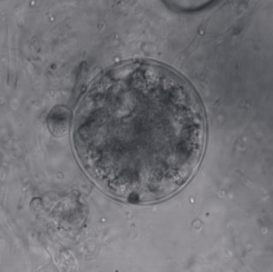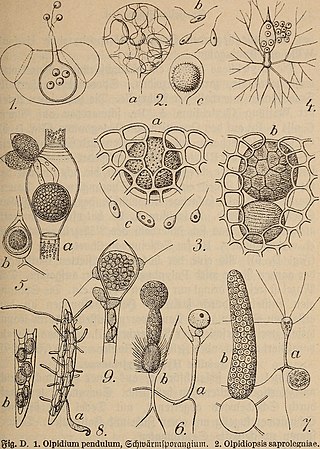
Chytridiomycota are a division of zoosporic organisms in the kingdom Fungi, informally known as chytrids. The name is derived from the Ancient Greek χυτρίδιον (khutrídion), meaning "little pot", describing the structure containing unreleased zoospores. Chytrids are one of the earliest diverging fungal lineages, and their membership in kingdom Fungi is demonstrated with chitin cell walls, a posterior whiplash flagellum, absorptive nutrition, use of glycogen as an energy storage compound, and synthesis of lysine by the α-amino adipic acid (AAA) pathway.

Karl Otto Stetter is a German microbiologist and authority on astrobiology. Stetter is an expert on microbial life at high temperatures.
Chytridiomycetes is a class of fungi. Members are found in soil, fresh water, and saline estuaries. They are first known from the Rhynie chert. It has recently been redefined to exclude the taxa Neocallimastigomycota and Monoblepharidomycetes, which are now a phylum and a sister-class respectively.

Blastocladiomycota is one of the currently recognized phyla within the kingdom Fungi. Blastocladiomycota was originally the order Blastocladiales within the phylum Chytridiomycota until molecular and zoospore ultrastructural characters were used to demonstrate it was not monophyletic with Chytridiomycota. The order was first erected by Petersen for a single genus, Blastocladia, which was originally considered a member of the oomycetes. Accordingly, members of Blastocladiomycota are often referred to colloquially as "chytrids." However, some feel "chytrid" should refer only to members of Chytridiomycota. Thus, members of Blastocladiomycota are commonly called "blastoclads" by mycologists. Alternatively, members of Blastocladiomycota, Chytridiomycota, and Neocallimastigomycota lumped together as the zoosporic true fungi. Blastocladiomycota contains 5 families and approximately 12 genera. This early diverging branch of kingdom Fungi is the first to exhibit alternation of generations. As well, two (once) popular model organisms—Allomyces macrogynus and Blastocladiella emersonii—belong to this phylum.
Symbiotaphrina is a genus including seven species of fungi in the monotypic family Symbiotaphrinaceae Baral & E. Weber and the monotypic order Symbiotaphrinales Baral & E. Weber.

Sporobolomyces is a genus of fungi in the subdivision Pucciniomycotina. Species produce both yeast states and hyphal states. The latter form teliospores from which auricularioid (tubular and laterally septate) basidia emerge, bearing basidiospores. Yeast colonies are salmon-pink to red. Sporobolomyces species occur worldwide and have been isolated (as yeasts) from a wide variety of substrates. They produce ballistoconidia that are bilaterally symmetrical, they have Coenzyme Q10 or Coenzyme Q10(H2) as their major ubiquinone, they lack xylose in whole-cell hydrolysates, and they cannot ferment sugars. One species, Sporobolomyces salmonicolor, is known to cause disease in humans.

Otto Kandler was a German botanist and microbiologist. Until his retirement in 1986 he was professor of botany at the Ludwig Maximilian University of Munich.
Frederick Kroeber Sparrow was an American mycologist. He was known for his research on aquatic fungi, and in particular the genus Physoderma, and he produced a well-received monograph in 1943 titled The Aquatic Phycomycetes Exclusive of the Saprolegniacea and Pythium; this was republished in 1960 as Aquatic Phycomycetes.
Hyphomicrobium vulgare is a bacterium from the genus of Hyphomicrobium.
Penicillium cyaneum is a species of the genus of Penicillium which was isolated from an oil-field. Penicillium cyaneum produces fatty acid, Brefeldin A and the antibiotic Cyanein
Penicillium isariiforme is an anamorph, phototropic species of the genus of Penicillium which produce secalonic acid D and F.
Penicillium javanicum is an anamorph species of the genus of Penicillium which produces xathomegnin.
Penicillium palitans is an anamorph species of fungus in the genus Penicillium which was isolated from cheese and ancient permafrost deposits. Penicillium palitans produces viridicatin, cyclopiazonic acid, roquefortine, palitantin and ochratoxin A
Streptomyces orinoci is a bacterium species from the genus of Streptomyces which has been isolated from soil. Streptomyces orinoci produces the antibiotics spectinabilin, neoantimycin, neoaureothin and ochramycin.
Streptomyces violascens is a bacterium species from the genus of Streptomyces which has been isolated from soil. Streptomyces violascens produces violapyrone A – G, L-glutamate oxidase and albaflavenoid.

Chytridium is a genus of fungi in the family Chytridiaceae.

The genus Aplanochytrium is part of the class Labyrinthulomycetes. It is a sister genus of Labyrinthula and thraustochytrids. The major characteristic of all three genera is the production of an extension of the plasma membrane and the ectoplasm called the ectoplasmic net, but its use is different in each genera. Aplanochytrium cells are not embedded in the ectoplasmic net but can move by gliding on the ectoplasmic threads.
Nitrospinota is a bacterial phylum. Despite only few described species, members of this phylum are major nitrite-oxidizing bacteria in surface waters in oceans. By oxidation of nitrite to nitrate they are important in the process of nitrification in marine environments.
Hilda Mabel Canter-Lund was an English mycologist, protozoologist, and photographer. She worked as a mycologist and then as a senior principal scientific officer at the laboratories of the Freshwater Biological Association. Canter took photographs and several of them were exhibited in multiple publications and published more than 74 papers of which 25 were in collaboration with colleagues. She received a fellowship from the Royal Photographic Society, the Benefactor's Medal from the British Mycological Society (BMS) and was elected an centennial fellow of the BMS. A photographic award in Canter's honour was established by the British Phycological Society.
Hyalochlorella marina, the only species in the genus Hyalochlorella and also known as Dermocystidium sp., is a marine heterotrophic eukaryote with uncertain phylogenic position.






